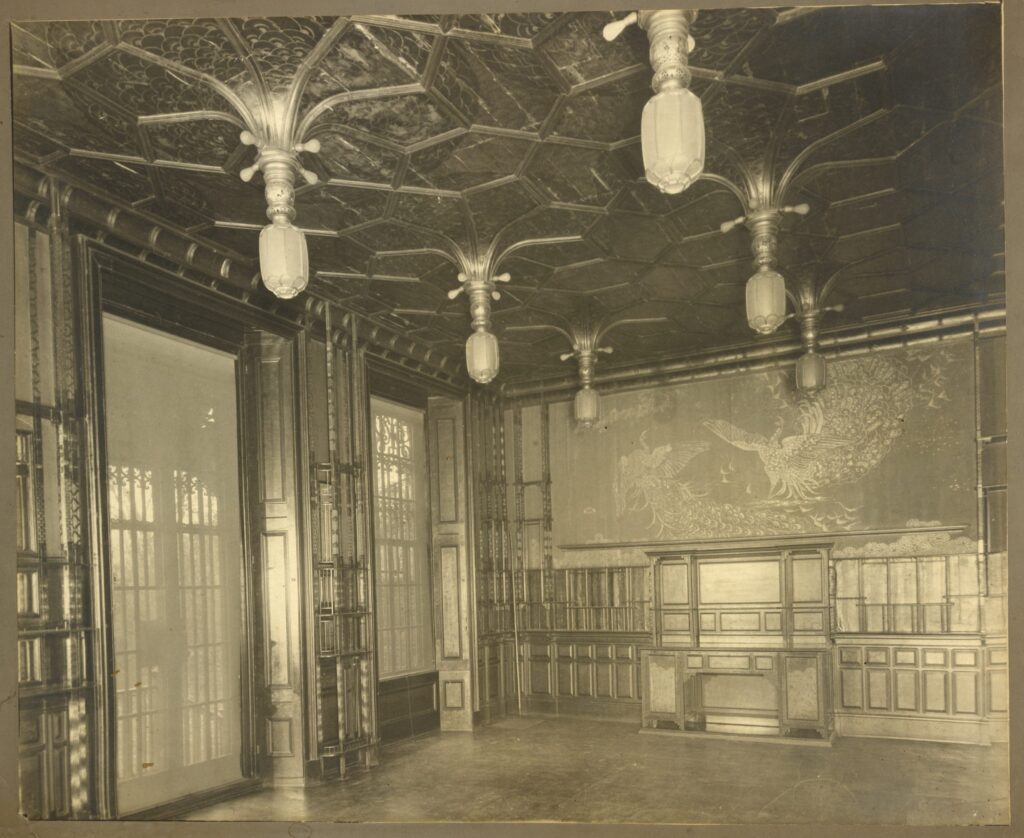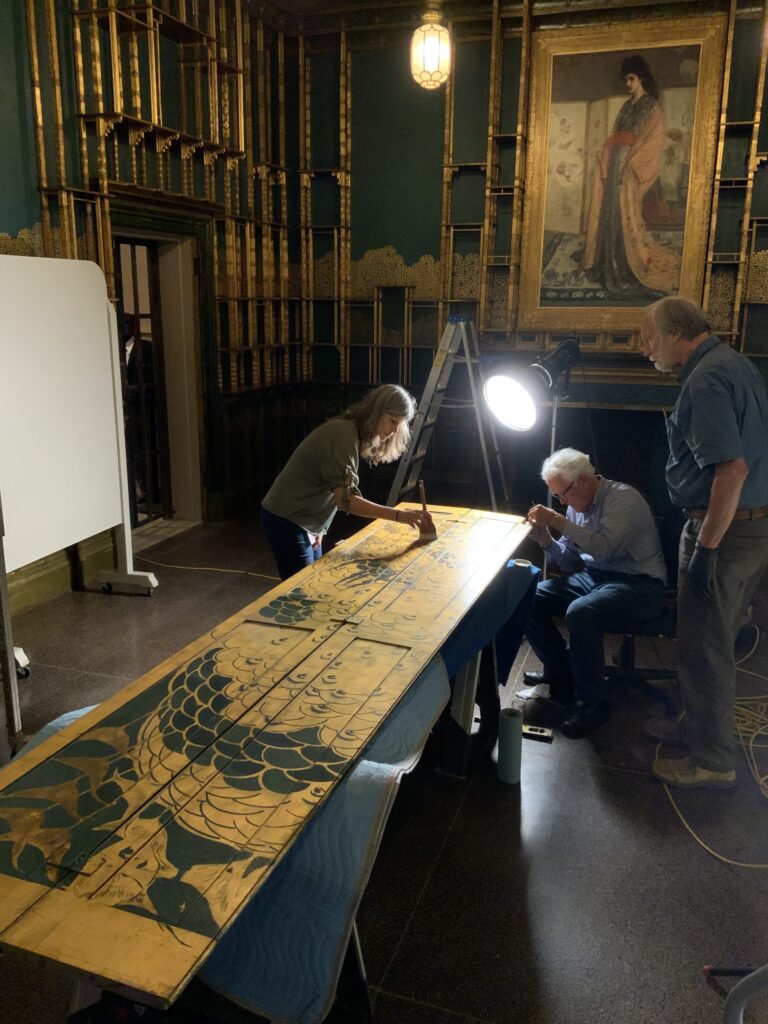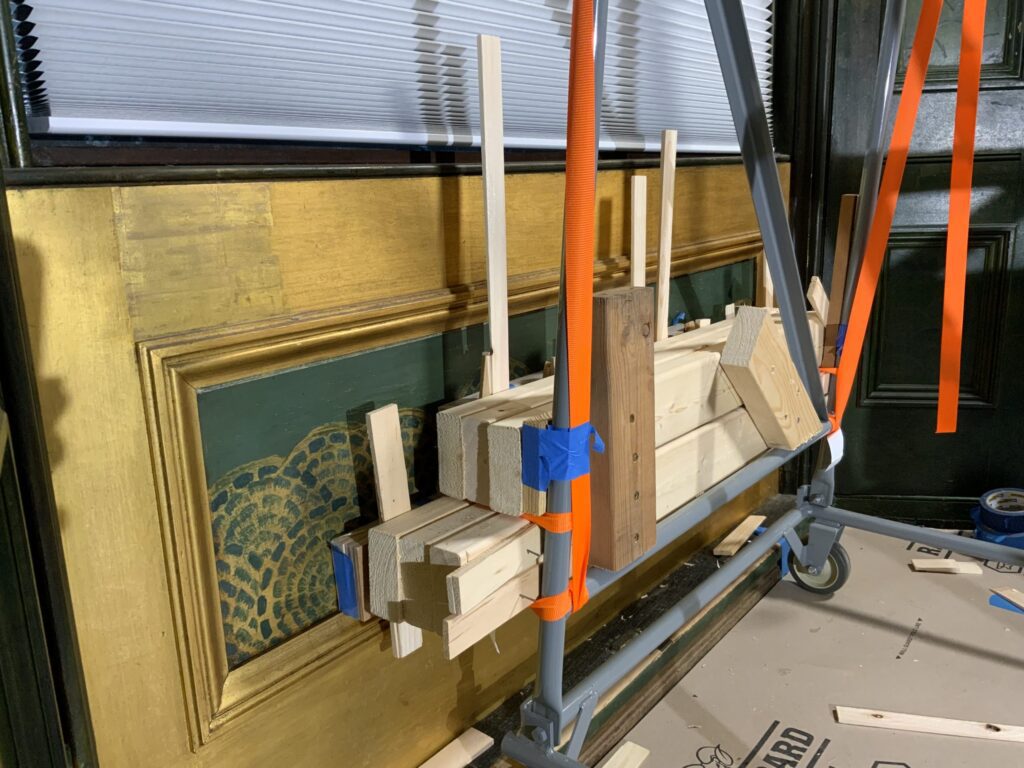By Ellen Chase and Jenifer Bosworth
Reprinted from ASIA.SI Blog Post, September 21, 2022
The first phase of the Peacock Room conservation project ended in July after two months of intense activity by NMAA staff and Aeon Preservation, specialists in architectural conservation. This phase of the treatment on the shutters, windows, window surrounds, and vents has improved their condition, appearance, and function, and it has brought to light new information about the room’s previous treatment and history. The issues which have been addressed are detailed in an earlier post in this series.
We solved the problem of the shutters catching and abrading the sills by lightly sanding the unpainted bottoms of the shutters. We did this work on two sets of shutters while they were open in place; however, we treated the third set of shutters differently because they were catching at the corners. In this instance, we removed the set of shutters from the window casings so we would have better access to the problem areas.
Sanding alone was not enough for the tall middle shutters, which were sticking badly at the center of the sill. Historic photos of the Peacock Room in Charles Lang Freer’s house in Detroit show there was originally a doorway behind the tall center shutters, making it clear that the center sill is not an original part of the Peacock Room and was added when the room came to the Freer Gallery. This information factored into our decision to plane down an area of the sill to provide room for the shutters to move easily.
Historic photos and the marked difference in the painting style of the central window panel confirmed that this panel also was not original to the room and was made for the Freer installation. We set the cracked and lifting veneer of the panel in place by using glue behind the veneer. Aeon Preservation conservators developed an ingenious way to apply pressure to the veneer while the glue set. Notched bars made with lumber were strapped to a ladder and held in place with heavy weights. Wood shims were then slid between the notches to apply pressure as needed along the entire face of the dado panel, as shown in one of the photos below.
We inspected splits and gaps in the window surrounds and the moldings around the shutters, and these seemed to be the result of the Peacock Room having been relocated and reassembled multiple times. We brought these elements back into alignment and stabilized them.
In the process of conserving artworks, we often make new discoveries about them. Prior to this project, the decorative vent surrounds in each corner of the Peacock Room were thought to be part of the Freer Gallery installation. But uneven wear patterns close to room corners where there could be no foot traffic led us to look more closely at historic photos. We discovered that the decorative vent surrounds may actually originate from Freer’s house in Detroit. The uneven surfaces are possibly due to the vents being brought from Detroit and reused in the gallery without regard to their original orientation. While there are only two vents visible in photographs of the Peacock Room in Freer’s home, four vents are included in the current format in the Freer Gallery, so we are still investigating when the two extra vents were added.
We described the removal of the old adhesive on the metal surface of the vents in our previous blog. We completed this project and reduced the black waxy material on the surface. However, once we removed this material, the surface appeared mottled and uneven. Conservators used pigmented wax to even out the appearance and to help highlight the decorative patterns. We then applied a protective coating to the metal.
Conservators finished phase one work by setting down the flaking paint on the shutter exteriors. Once the lifting paint was stable, areas of loss on the shutters and their surrounds were inpainted to be less distracting. As a visitor to the Peacock Room, you won’t be able to notice these areas of inpainting, but they are carefully documented and are visible up close so that future conservators can detect them. We applied a protective coating to the shutter exteriors after inpainting to help protect them from fluctuations in humidity and temperature along the outside gallery wall.
The second phase of the conservation project has begun as staff conservators and a new group of contractors with specific expertise in painted surfaces work to clean the surfaces of the rest of the Peacock Room. Stay tuned for updates on this work and more as we approach the reopening of the Peacock Room next month!






